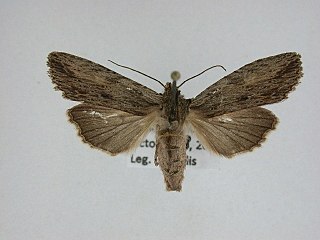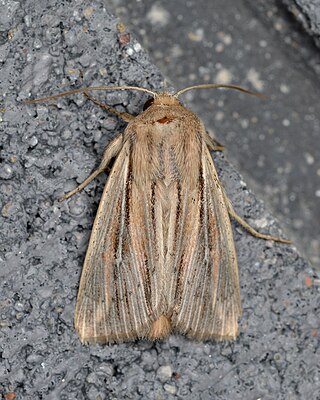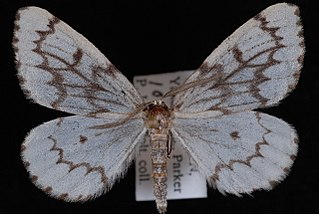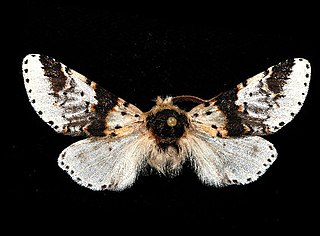Tarache terminimaculata, the curve-lined bird-dropping moth, is a species of moth in the family Noctuidae. The species was described by Augustus Radcliffe Grote in 1873. It is found in North America.

Helotropha reniformis, the reniform celaena, is a species of moth in the family Noctuidae. The species was described by Augustus Radcliffe Grote in 1874. It is found in North America.

Lithophane signosa, the signate pinion or sycamore pinion moth, is a species of moth in the family Noctuidae. The species was described by Francis Walker in 1857. It is found in North America.
Plagiomimicus aureolum is a species of moth in the family Noctuidae. It was described by Henry Edwards in 1882 and is found in North America, where it has been recorded from Arizona, western Texas and New Mexico.
Parabagrotis cupidissima is a species of moth in the family Noctuidae. It was described by Augustus Radcliffe Grote in 1875 and is found in North America, where it ranges from southern Vancouver Island, along the Pacific Coast states, to southern California. The habitat consists of grasslands and oak woodlands.
Sphingicampa bisecta, the bisected honey locust moth, is a species of moth in the family Saturniidae. The species was described by Joseph Albert Lintner in 1879. It is found in North America.
Parabagrotis insularis is a species of moth in the family Noctuidae. It is found in North America, where it has been recorded from southern Vancouver Island, along the Pacific Coast through California to near the border with Mexico. The species was described by Augustus Radcliffe Grote in 1876.
Xestia verniloides is a species of cutworm or dart moth in the family Noctuidae. It was described by J. Donald Lafontaine in 1998 and is found in North America.
Oligia bridghamii, or Bridgham's brocade, is a species of cutworm or dart moth in the family Noctuidae. It was described by Augustus Radcliffe Grote and Coleman Townsend Robinson and is found in North America.

Leucania commoides, the comma wainscot or two-lined wainscot moth, is a species of cutworm or dart moth in the family Noctuidae. It was described by Achille Guenée in 1852 and is found in North America.
Pseudeustrotia indeterminata is a species of cutworm or dart moth in the family Noctuidae. It was described by William Barnes and James Halliday McDunnough in 1918 and is found in North America.

Nepytia phantasmaria, the phantom hemlock looper, is a species of geometrid moth in the family Geometridae. It was described by Herman Strecker in 1899 and is found in North America.

Idaea basinta, the red-and-white wave, is a species of geometrid moth in the family Geometridae. It was described by William Schaus in 1901 and is found in Central and North America.
Zale obsita is a species of moth in the family Erebidae. It was described by Achille Guenée in 1852 and is found in North America.
Xestia laxa is a species of cutworm or dart moth in the family Noctuidae. It was described by J. Donald Lafontaine and Kauri Mikkola in 1998 and is found in North America.

Furcula scolopendrina, the zigzag furcula moth or poplar kitten moth, is a species of prominent moth in the family Notodontidae. It was described by Jean Baptiste Boisduval in 1869 and is found in North America.

Tesagrotis corrodera is a species of cutworm or dart moth in the family Noctuidae. It was described by Smith in 1907 and is found in North America.
Meropleon linae is a species of cutworm or dart moth in the family Noctuidae. It is found in North America.
Meropleon cosmion is a species of cutworm or dart moth in the family Noctuidae. It is found in North America.
Meropleon cinnamicolor is a species of cutworm or dart moth in the family Noctuidae. It is found in North America.







